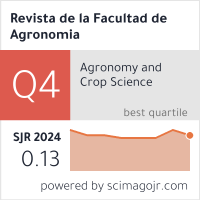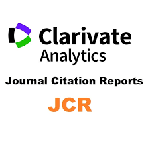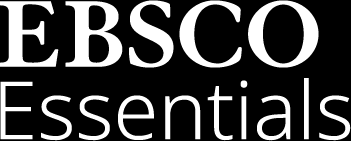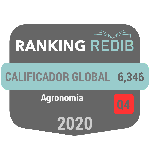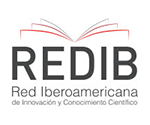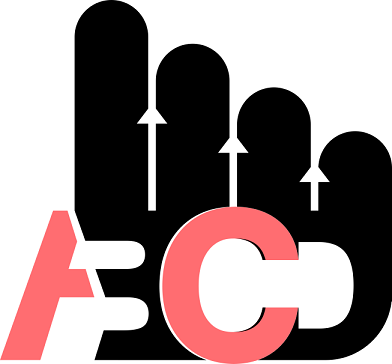Effect of Saccharomyces cerevisiae and nitrogen compounds on the fermentation of banana pulp (Musa spp.)
Abstract
The use of agro-industrial by-products, such as banana pulp (Musa spp.), represents a sustainable alternative for animal production, reducing costs and improving resource utilization. The study aimed to evaluate the effect of Saccharomyces cerevisiae, urea, and ammonium sulfate on the nutritional value of banana pulp, seeking to optimize its bromatological properties to transform it into a nutritionally viable and sustainable input. A completely randomized experimental design with a factorial arrangement was employed, considering two treatment levels: 1 % Saccharomyces cerevisiae, 0.8 % urea, and 0.1 % ammonium sulfate, and 1.5 % Saccharomyces cerevisiae, 1 % urea, and 0.2 % ammonium sulfate. The aerobic fermentation times studied were 2, 4, and 6 hours. The results showed that the best bromatological quality was achieved at 6 hours with 1 % Saccharomyces cerevisiae, 0.8 % urea, and 0.1 % ammonium sulfate. However, the most economically efficient treatment was obtained with 1.5 % Saccharomyces cerevisiae, 1 % urea, and 0.2 % ammonium sulfate in 4 hours of fermentation, due to its lower energy consumption. These findings highlight the potential of banana pulp treated as a cost-effective and sustainable input, contributing to more efficient animal production systems.
Downloads
References
Briz, N., Eva, J., Rial, R., & Simal, J. (2016). Proteome changes in Garnacha Tintorera red grapes during post-harvest drying. Lwt-Food Science and Technology, 69, 608-613. https://doi.org/10.1016/j.lwt.2016.02.026
Fernandez, R., Contreras, J., Curasma, J., Cordero, A., Rojas, Y., Ruiz, D., & Huaman, R. (2021). Effect of Saccharomyces cerevisiae and fermentation times on the chemical composition of oat and barley silage. Revista de Investigaciones Veterinarias del Perú, 32(6), 1-8. http://dx.doi.org/10.15381/rivep.v32i6.21681
Gu, Y., Cai, F., Zhu, Z., Dai, Z., Chen, C., & Liu, G. (2020). Improving the methane production from zucchini stem by response surface methodology and different pretreatments. Industrial Crops and Products, 150, 112402. https://doi.org/10.1016/j.indcrop.2020.112402
Kong, J., Zhang, Y., & Ju, J. (2019). Antifungal effects of thymol and salicylic acid on cell membrane and mitochondria of Rhizopus stolonifer and their application in postharvest preservation of tomatoes. Food Chemistry, 285, 380-388. https://doi.org/10.1016/j.foodchem.2019.01.099
Mohd, H., Roslan, J., Saallah, S., Munsu, E., Shaeera, N., & Pindi, W. (2022). Banana peels as a bioactive ingredient and its potential application in the food industry. Journal of Functional Foods, 92(105054), 1-12. https://doi.org/10.1016/j.jff.2022.105054
Mutsokoti, L., Panozzo, A., & Tongonya, J. (2017). Carotenoid stability and lipid oxidation during storage of low-fat carrot and tomato based systems. Lwt-Food Science and Technology, 2017, 470-478. https://doi.org/10.1016/j.lwt.2017.03.021
Poel, V., Abdollahi, J., Cheng, H., Colovic, R., Hartog, L., Miladinovic, D., Página, G., Sijssens, K., Smillie, J., Thomas, U., Wang, W., & Hendriks, W. (2020). Future directions of animal feed technology research to meet the challenges of a changing world. Animal Feed Science and Technology, 270(114692), 1-12. https://doi.org/10.1016/j.anifeedsci.2020.114692
Rigueira, J. P. S., De Jesus, N. G., Júnior, V. R. R., Monção, F. P., Costa, N. M., David, G. S. S., Vieira E Silva, F., & Da Cunha Siqueira Carvalho, C. (2021). Effects of different banana crop wastes on nutrient intake and digestibility, microbial protein synthesis, feeding behavior, and animal performance of ¾ Holstein × Zebu heifers in a semiarid rangeland. Tropical Animal Health and Production, 53(2), 209. https://doi.org/10.1007/s11250-021-02660-z
Salazar, N., Barco, G., Zuñiga, S., Domínguez, A., Robles, M., Villegas, M., & González, G. (2022). Single-Cell Protein production as a strategy to reincorporate food waste and agro by-products back into the processing chain. Bioengineering, 9(11), 1-13. https://doi.org/10.3390/bioengineering9110623
Simeanu, D., & Razvan, R. (2023). Animal Nutrition and Productions. Agriculture, 13(943), 1-10. https://doi.org/10.3390/agriculture13050943
Souza, C.P.L., Pereira, A.d.S., Aguieiras, É.C.G., & Amaral, P.F.F. (2025). Sequential Solid-State and Submerged Fermentation to Increase Yarrowia lipolytica Lipase Production from Palm Oil Production Chain By-Products. Fermentation, 11(3), 1-16. https://doi.org/10.3390/fermentation11010003
Suárez, C., Garrido, N., & Guevara, C. (2016). Levadura Saccharommyces cerevisiae y la producción de alcohol. Revisión bibliográfica. ICIDCA. Sobre los Derivados de la Caña de Azúcar, 50(1), 20-28.
Vásquez, L., Alvarado, K., Intriago, F., Raju, N., & Prasad, R. (2024). Banana and apple extracts with efficient microorganisms and their effect on cadmium reduction in cocoa beans (Theobroma cacao L.). Discover Food, 4(163), 1-13. https://doi.org/10.1007/s44187-024-00205-5
Vásquez, L., Vera, J., Erazo, C., & Intriago, F. (2022). Induction of rhizobium japonicum in the fermentative mass of two varieties of cacao (Theobroma Cacao L.) as a strategy for the decrease of cadmium. International Journal od Health Sciences, 6(3), 11354-11371. https://doi.org/10.53730/ijhs.v6nS3.8672 Induction
Vera Chang, J., Frank Intriago F., Vásquez Cortez, L., & Alvarado Vásquez, K. (2022). Inducción anaérobica de Bradyrhizobium japonicum en la postcosecha de híbridos experimentales de cacao y su mejoramiento en la calidad fermentativa. Journal of Science and Research, 7(2), 19–23. https://doi.org/10.5281/zenodo.7723254
Yang, X., Yang, Y., Huang, J., Man, D., & Guo, M. (2021). Comparisons of urea or ammonium on growth and fermentative metabolism of Saccharomyces cerevisiae in ethanol fermentation. World Journal of Microbiology and Biotechnology, 37(6), 98. https://doi.org/10.1007/s11274-021-03056-9
Copyright (c) 2025 Juan Carlos Medina Fonseca, Juan Carlos Gómez Villalva, Luis Humberto Vásquez Cortez, Edwin Amado Mendoza Hidalgo, Álvaro Martín Pazmiño Pérez, Jhoan Alfredo Plua Montiel

This work is licensed under a Creative Commons Attribution-NonCommercial-ShareAlike 4.0 International License.
